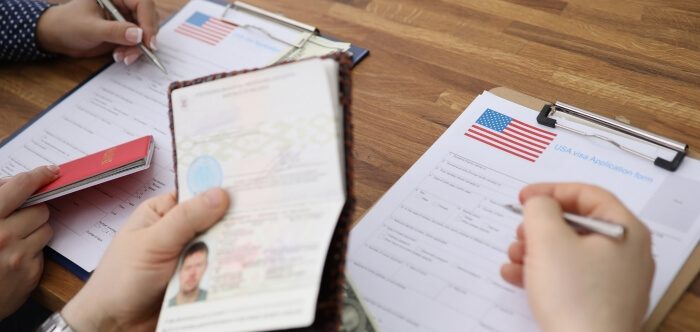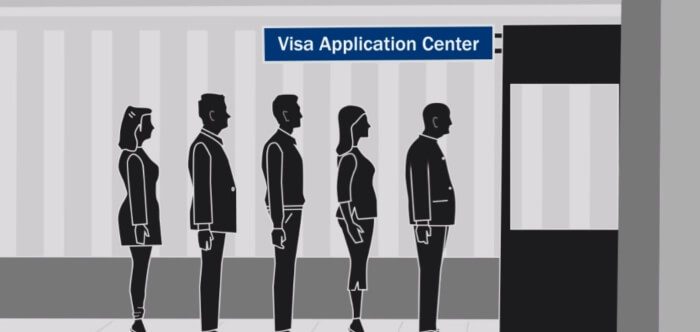It can be difficult to understand the intricacies of US visa applications, particularly when you come across words like biometrics. But don’t worry! Although technically complex, the procedure has been reduced for maximum security and speed. So, what do you need to know about Biometrics for a US Visa?
Biometrics captures your unique physical traits, such as fingerprints and facial scans, ensuring your identity is authentic. Whether you’re boarding on an academic pursuit, chasing the American dream job, or simply vacationing, this vital step cannot be bypassed.
By understanding its significance and ensuring compliance, your visa journey will be smoother. Curious about the details? Dive deeper into this article and arm yourself with the knowledge to ensure a successful visa application.
Brief Summary of The US Visa Application Process
The US visa application process comprises several critical steps. Applicants must determine the appropriate visa category based on their purpose for traveling to the United States. This categorization is essential as it dictates the specific requirements and forms that need to be completed.
Once the visa category is established, applicants must complete the DS-160 form online, providing detailed personal information and background. It’s crucial to ensure accuracy in this step, as any errors or discrepancies can lead to delays or denials in the application process.
After completing the DS-160, applicants are required to pay the non-refundable visa application fee. Payment methods may vary depending on the US Embassy or Consulate location. Once the fee is paid, applicants will receive a unique payment receipt, which is necessary for scheduling the visa interview, the next vital step in the process.
What is Biometrics for a US Visa?
The realm of visa applications introduces applicants to various terminologies, one of which is biometrics. At its essence, biometrics for a US visa refers to the collection of unique physical identifiers. These include elements like fingerprints and facial scans, which are pivotal in verifying an individual’s identity.
In the vast landscape of security and identity verification, biometrics plays a central role. The US visa application process uses these captured traits to enhance the security and precision of its processing. This system not only deters fraudulent activities but also ensures that visas are granted to genuine applicants.
It’s not just about security; the integration of biometrics adds efficiency to the visa process, especially for those planning to experience scenic views or attend international conferences. After capturing these details, they’re stored in a secure database, facilitating quicker verifications in future encounters. Thus, biometrics streamlines both security and operational procedures in visa applications.
What Do You Need to Know About Biometrics for a US Visa?
Are you applying for a US Visa soon? Understanding what do you need to know about Biometrics for a US visa? is crucial. This essential step involves biometric data collection to enhance security and streamline the immigration process.
The Significance of Biometrics
Biometrics plays a pivotal role in safeguarding national security. By capturing unique physical traits like fingerprints and facial scans, it ensures that visa applicants are who they claim to be, preventing identity fraud.
The Biometric Data Collection Process
During your visa application journey, you will be required to attend a biometrics appointment. This involves the collection of your biometric data, such as fingerprints and facial photographs. This information is securely stored and used for identity verification.
Enhancing Immigration Efficiency
Biometrics not only enhances security but also expedites the immigration process. It reduces the chances of visa fraud, leading to quicker and more accurate identification, and benefiting both applicants and authorities.
Types of US Visas and Biometrics
The role of biometrics varies depending on the type of US visa you are applying for. Tourist, student, and work visas all involve biometric data collection. However, the specific requirements and the extent of biometric data usage may differ. Understanding these nuances is essential to ensure you meet the criteria for your particular visa category.
Compliance and Documentation
To ensure a smooth visa application process, compliance with biometric requirements is paramount. Each visa category has its own set of documentation and guidelines for biometric data submission. Make sure to carefully review the specific requirements for your visa type to avoid any delays or complications in your application.
Preparing for Your Biometrics Appointment
Scheduling and preparing for your biometrics appointment is a crucial step. Ensure you have all the necessary documents, such as your appointment confirmation and valid identification. Familiarize yourself with the location of the biometrics center, the appointment duration, and what to expect during the appointment to help you feel confident and prepared on the day of your visit.
Grasping the essentials of biometrics for a US visa is pivotal for a successful application process. It enhances security, expedites immigration, and ensures a smoother visa journey for travelers with diverse purposes.
The Process of Biometrics Data Collection
The process of biometrics data collection is a crucial step in enhancing security measures, particularly in visa application procedures. This comprehensive process ensures the accurate capture and verification of an individual’s unique physical and facial characteristics.
Fingerprint Data Collection
Fingerprint data collection involves using specialized fingerprint scanners to capture the unique ridges and patterns of an individual’s fingertips. The scanner records this information and converts it into a digital format, creating a fingerprint template.
Facial Recognition
Facial recognition employs digital cameras or webcams to capture an individual’s facial features. The camera takes a photograph of the person’s face, and software analyzes the data to identify key facial landmarks, creating a digital facial template.
Iris Scanning (Optional)
In some high-security applications, iris scanning is used. Iris scanners capture the intricate patterns of the colored part of the eye, known as the iris. This data is transformed into a digital template for identification.
Voice Recognition (Occasionally)
Voice biometrics records an individual’s voice to analyze specific vocal characteristics like pitch and tone. While less common in certain biometric applications, it’s used for voice-based identity verification.
Data Storage and Encryption
The digital biometric data collected, whether fingerprints, facial images, or iris scans, is stored securely in databases maintained by government agencies. This data is typically encrypted to safeguard privacy during transmission and storage.
Data Matching and Identity Verification
When an individual presents themselves for a biometrics check, the collected data is compared against the stored templates in the database. Complex algorithms analyze the data for similarities, verifying the person’s identity.
Biometric data collection captures unique physical and facial features with special tools, turns them into digital templates, secures and encrypts the data, and uses it for identity verification, making processes safer and faster in many areas. This enhanced security is a key advantage of the process after biometrics.
Tips for a Smooth Biometrics Collection Experience
The biometrics collection is a pivotal part of the US visa application process, where applicants provide unique physical and facial data to verify their identity. To ensure a seamless experience, preparation is key. Here are some tips to facilitate a smooth biometrics session.
- Be Punctual: Arriving on time for your appointment is crucial. Tardiness could lead to rescheduling. Always account for possible traffic or transit delays.
- Clean Hands are Essential: Ensure your hands are clean and free from cuts. Lotions or residues might affect fingerprint clarity. Fresh injuries can also distort readings.
- Present Required Documents: Have all the necessary documents ready and accessible. This typically includes your appointment confirmation and passport. Quick document access speeds up the process.
- Dress for a Photo: Remember, a facial scan will be taken. Wear neutral clothing and avoid excessive makeup or accessories. This ensures a clear, representative image.
- Stay Calm and Composed: Nervousness can lead to complications. Approach the session with a calm mindset. Clear communication with the technician aids in accuracy.
- Follow Instructions Carefully: Listen intently to the given directives. Each biometrics machine might have slight variations. Proper positioning ensures quality data capture.
- Ask Questions if Unsure: If something isn’t clear, seek clarification. The technicians are there to assist. Understanding each step will prevent potential mishaps.
- Avoid Using Electronics: Mobile phones or other devices can be distractions. Turn them off or set them to silent. Focus solely on the biometrics process.
- Confirm Data Submission: Before leaving, ensure your data has been successfully captured. Anomalies can sometimes occur. It’s better to rectify issues immediately.
- Keep Your Biometrics Receipt: Upon completion, you’ll receive a receipt. Safeguard this as proof of your biometrics submission. It may be needed for future reference.
Conclusion
It is crucial to understand “What do you need to know about Biometrics for a US Visa?” in order to apply for a visa successfully. Biometrics, which include distinct physical characteristics like fingerprints and facial scans, is an essential stage in guaranteeing the process’s efficiency and security. It’s actually designed to make the application more secure and seamless, so it’s not as hard as it sounds.
By appreciating the importance of biometrics and making sure you meet the requirements, you can manage the visa application process with ease. Whether you’re heading to the US for education, work, or leisure, this knowledge empowers you to start on your journey with confidence.
So, keep these insights in mind as you board on your visa application, and prepare to hold all the exciting opportunities that await you in the US.








